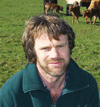Farm health planning: Strict biosecurity keep disease out

Bringing BVD-infected cattle into contact with naïve animals can result in devastating consequences – abortions, infertility and the subsequent birth of persistently infected calves.
Fortunately, beef producers Andrew and Kate Redwood of Haye Farm, St Dominic, Cornwall, were able to avert such a disaster thanks to having a close working relationship with their vet on health and disease issues, as part of an XLVets farm health planning project.
Through the DEFRA-funded project, the Redwoods have been taking advantage of a year of advice on herd health planning from their vet, Stuart Gough of Calweton Vet Practice.
Like many beef farmers, Mr Redwood had previously kept vet input to a minimum, to save costs. He had converted to a low-input, organic system, with spring-calving suckler cows and sheep, marketing organic beef and lamb.
Health status
Assessing the health status of a herd is one of the first steps in health planning, and so cattle were blood tested for infectious diseases BVD and leptospirosis.
The suckler herd has been a closed herd for the past seven years and it tested totally naïve to the BVD virus no animals were actively carrying the virus and there was no evidence of cattle ever having been exposed to it.
Mr Redwood explains: “At the time, I was looking to buy in some cattle to boost numbers. Fortunately, thanks to our focus on health, we were in the process of testing for BVD and realised the herd’s naïve status. We’ve put purchases on hold for now and are putting more heifers to the bull to avoid buying trouble in.”
Test results also showed evidence of leptospirosis: “This disease could account for some of the herd’s poor reproductive performance in the past. On Stuart’s advice we are vaccinating just the breeding cattle and then monitoring calves for exposure.”
Biosecurity
To prevent new disease entering the herd, Mr Gough has put together strict biosecurity protocols for the Redwoods to follow. Any new cattle must be blood tested before they are moved to the farm and will not be accepted at all if carrying BVD. And, given a choice, animals with no sign of leptospirosis infection will be favoured over those which will require vaccination against it.
Also as part of the health planning process, faecal samples were taken from sheep and cattle and tested for worms and parasites. “Some of the land grazed by breeding stock is old marshland which, coupled with last year’s wet summer, meant the risk of fluke was high.
“Tests early on in the project proved negative. But in later tests, adult larvae were found, so we obtained an organic derogation to use a flukicide.
“Fluke’s not been a major problem in the past, we’ve not had any reports of liver damage from the abattoir. However, it does affect performance, so we are going to monitor the situation and test again next year.”
Vet intervention
Another area where vet intervention has been beneficial is screening calves for respiratory diseases. Mr Redwood used to get one or two cases of pneumonia each year. Test results showed previous exposure to pneumonia viruses RSV and PI3, so 2007-born calves were vaccinated against these diseases before housing.
Meanwhile, a new cattle shed was erected at Haye Farm and simple structural changes made to existing housing to improve air flow.
Thanks to better housing and ventilation and the targeted vaccination programme, no calves needed antibiotic treatment for pneumonia over winter, despite it being a bad year for respiratory diseases.
A year is a short time in the production cycle of a beef suckler herd, so it is too soon to fully evaluate the full financial returns of herd health planning at Haye Farm. But through taking a proactive approach, Mr Redwood has averted a BVD infection disaster and is improving cattle and calf health through preventative treatments and/or improved housing.
Testing
“Health planning has worked well, highlighting areas I would not otherwise have been aware of. But every year is different, so I’m going to keep testing for at least the next three years to gain a better picture of the specific disease issues on the farm. With good biosecurity I would ultimately like to phase out drug use completely.”
